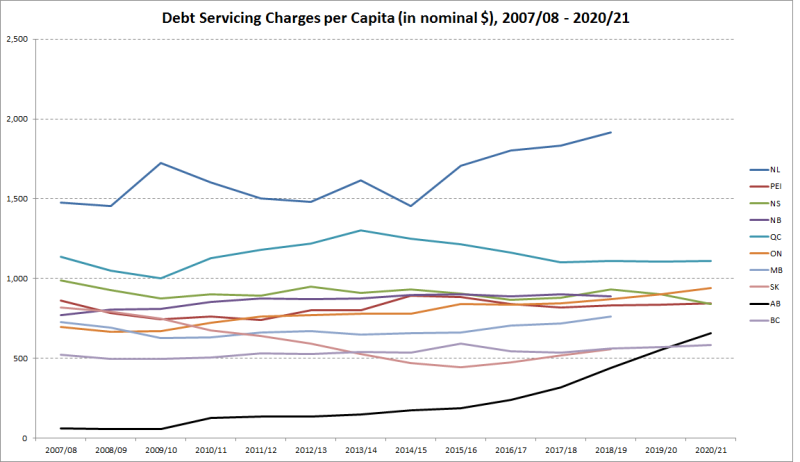Debt-servicing costs—Alberta catching up to other provinces

Until recently, Albertans paid very little to service provincial debt. This represented a significant fiscal advantage over every other province that had to spend substantial amounts of money each year paying interest on their debt.
Consider the 2007/08 fiscal year. That year, Alberta’s provincial government spent $61 per person on debt interest payments. Every other province spent much more—ranging from $521 per person per year in British Columbia to more than $1,000 per person per year in Quebec and Newfoundland.
In the rest of the country, these provincial debt interest payments siphoned off money that otherwise could have paid for public services or allowed room for tax relief. Alberta enjoyed this big advantage because it was the only province that did not carry a meaningful debt burden. In fact, in 2007/08, Alberta actually had a positive net asset position of $35 billion, meaning Alberta had more financial assets than debt.
In the past few years, however, all this has changed. Thanks primarily to a long string of deficits (that have gotten much larger since 2015/16), the provincial government has frittered away its net asset position and now has a net debt position of $30 billion. This number is climbing quickly, and will continue climbing for the foreseeable future.
Of course, all this new debt means that debt service costs are also quickly climbing. And the big advantage Alberta once enjoyed over other provinces is evaporating. The chart below illustrates this reality.

Alberta is rapidly catching up to B.C. and is projected to leapfrog its western neighbour in 2020/21. And while there are no available estimates for Saskatchewan beyond 2018/19, the pace of Alberta’s debt accumulation means Alberta will likely surpass its eastern neighbour within the next few years.
Again, if Alberta continues to rack up debt at anything close to its current rate, things will continue to get worse. Between 2017/18 and 2020/21, the province is forecasted to add approximately $100 per person in annual debt interest costs every year. If the province maintains a similar pace going forward, which is plausible, given the expected $7 billion deficit in 2020/21, it will only take three to four years before Alberta joins Quebec and Newfoundland as the only provinces paying more than $,1000 per person annually in debt interest costs (a dubious club that Ontario also seems poised to join).
So much for Alberta’s fiscal advantage with respect to interest payments on government debt.

